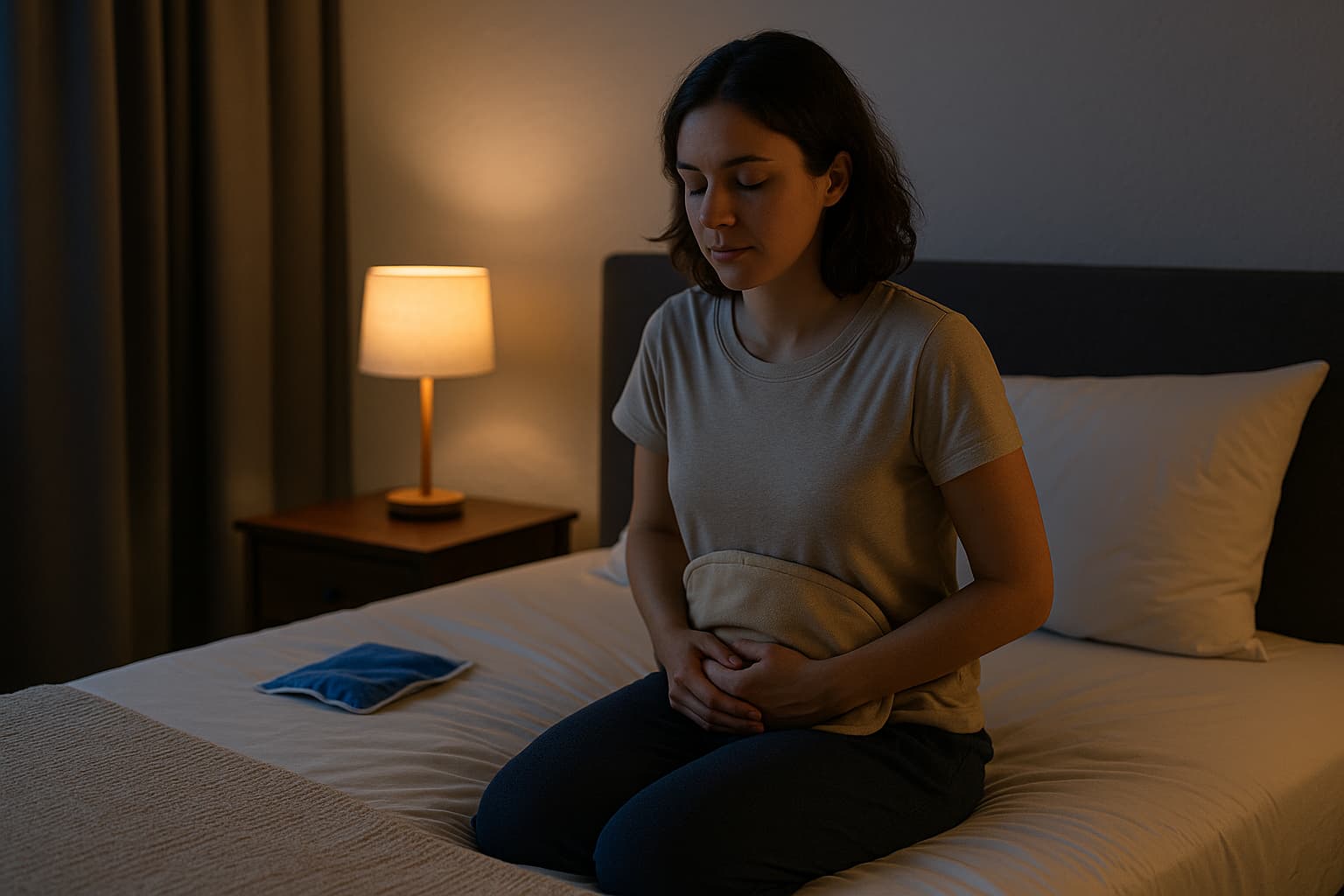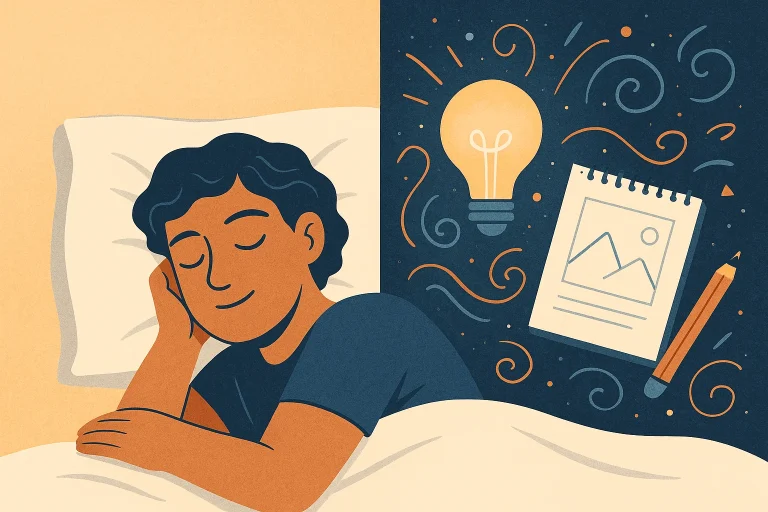Struggling at Night? Here’s How to Sleep Well Despite Chronic Pain
When you live with ongoing pain, getting a good night’s sleep can feel nearly impossible. You may finally lie down to rest, only to find your body tense, your mind alert, and every small ache suddenly much louder. Learning how to sleep well despite chronic pain isn’t easy — but it is possible with the right approach.
Pain affects sleep in two major ways: it makes it harder to fall asleep, and it disrupts the deeper stages of rest that help your body recover. Poor sleep can also heighten your sensitivity to pain the next day, creating a frustrating loop that’s hard to break.
This guide walks you through practical, evidence-informed strategies that help calm your body, support your sleep system, and lower nighttime discomfort. You’ll learn the essential foundations of sleeping well with chronic pain, the most supportive sleep positions, ways to reduce tension before bed, and simple techniques that make your nights more restful.
Let’s begin with the basics you need to understand before making meaningful changes.
How to Sleep Well Despite Chronic Pain: Key Foundations
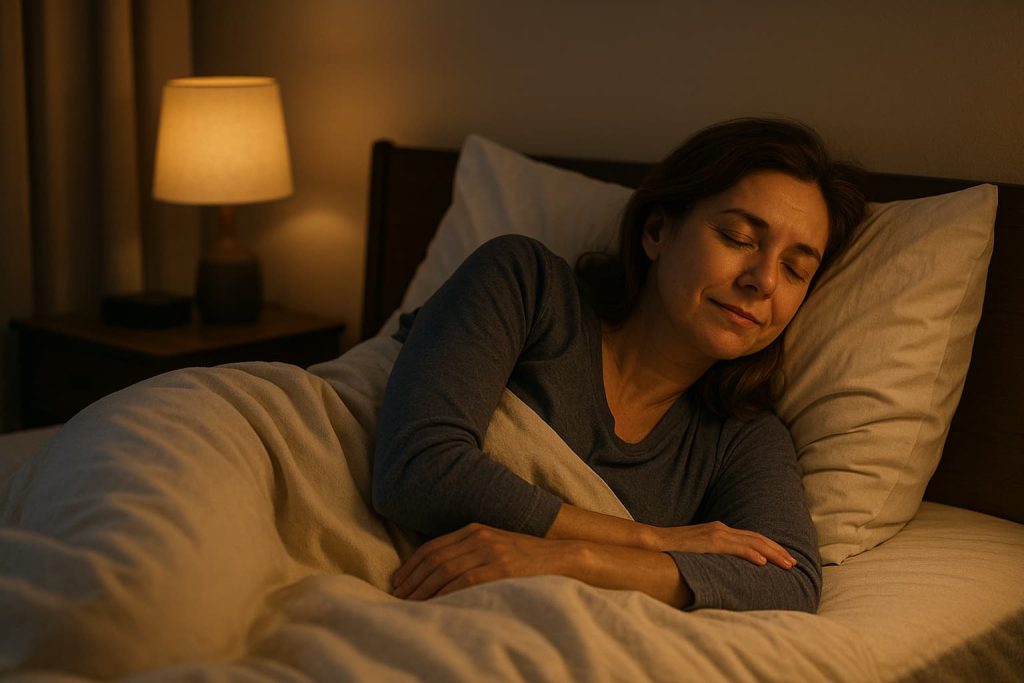
Chronic pain keeps the nervous system slightly activated, even when you’re trying to wind down. This makes falling asleep feel slow and disruptions more likely. Research shows that sleep and chronic pain influence each other in both directions — poor sleep increases pain sensitivity, and pain disrupts the deeper stages of rest.
(Source: Relationship Between Sleep Disturbances and Chronic Pain: A Narrative Review – PMC
Why Pressure Relief Matters
Your body relaxes best when it feels evenly supported. Even mild pressure on sensitive joints or muscles can cause tightening or discomfort that interrupts sleep. Reducing these pressure points — through posture, alignment, and surface comfort — helps the body stay calmer once you fall asleep.
The Role of Predictability in Better Sleep
A few steady cues — dim lighting, cooler air, and a familiar bedtime pattern — help the brain recognize that it’s safe to rest. Predictability supports the body’s natural sleep drive, especially when pain makes the brain more reactive to small disruptions.
4-Sleeping Position for Chronic Pain
Finding the best sleeping position for chronic pain can make nights noticeably easier. The goal is to reduce pressure on sensitive areas, keep your spine aligned, and prevent your muscles from working harder than they should while you rest. Different types of pain respond better to different positions, so experimenting is key.
Side Sleeping With Leg Support

Side sleeping is often the most comfortable option for chronic pain because it naturally minimizes pressure on the spine. Placing a small pillow between your knees helps keep your hips and lower back aligned, making this a good choice for hip discomfort, lower-back tension, and many types of leg pain.
Back Sleeping With Slight Knee Elevation
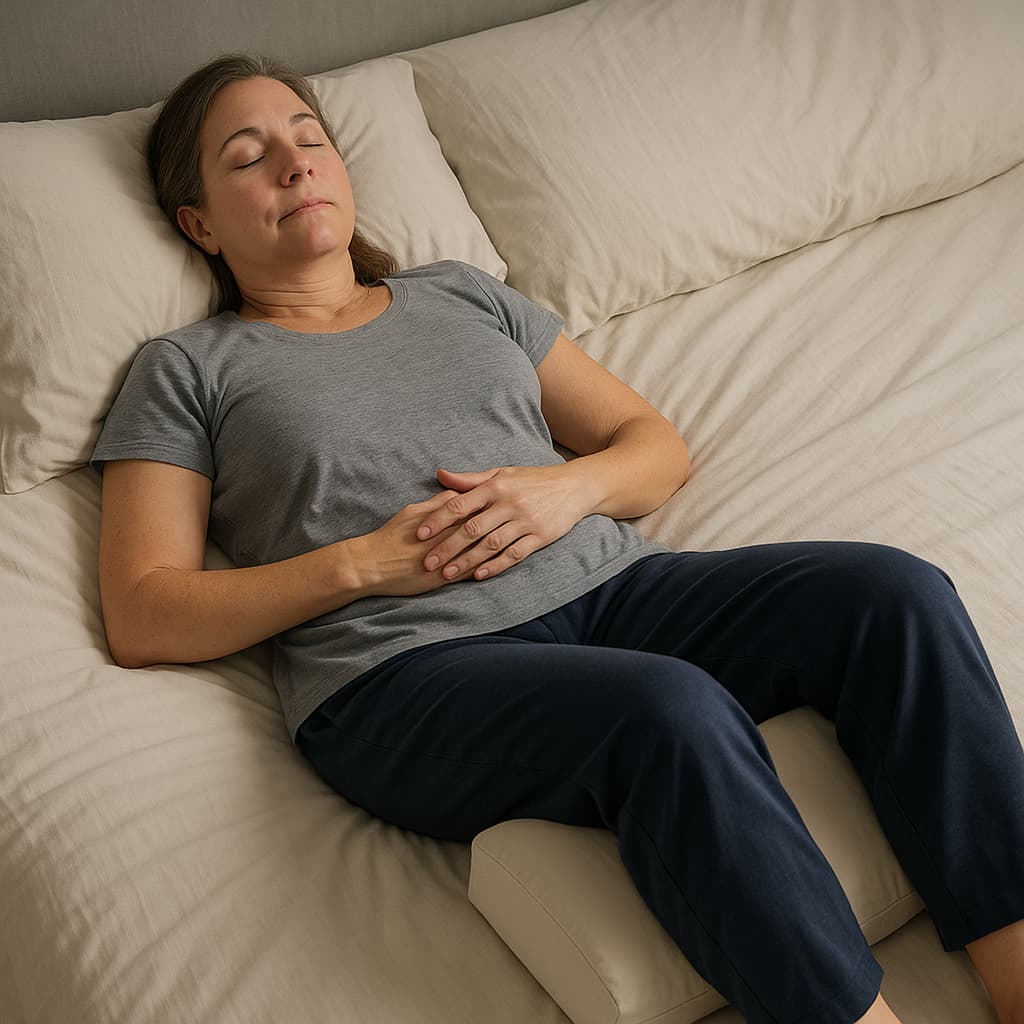
If you prefer sleeping on your back, raising your knees a few inches can help reduce arching in the lower spine. Using a soft cushion or rolled blanket under the knees allows your back to settle into a more neutral position, which may ease stiffness or soreness by morning.
Semi-Reclined Position for Lumbar or Nerve Pain
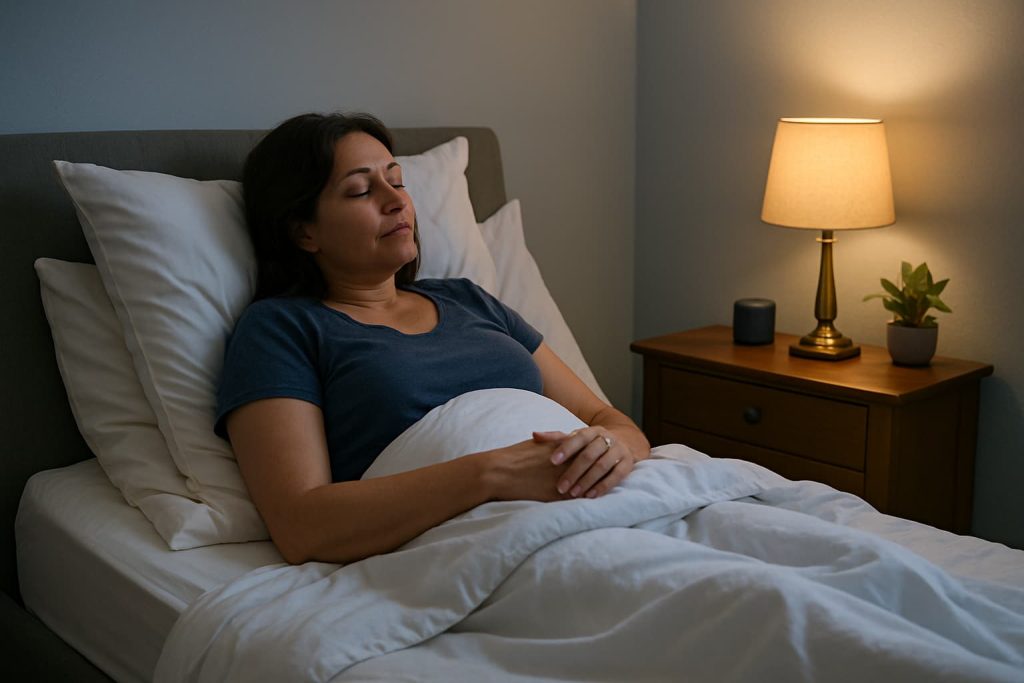
For people dealing with sciatica, lumbar pain, or nerve-related discomfort, a semi-reclined position can feel more supportive. Keeping the upper body slightly elevated reduces load on the lower spine while maintaining comfort for the hips and legs. This setup can also help lessen nighttime flare-ups caused by nerve compression or inflammation.
Why Stomach Sleeping Often Causes Problems
Stomach sleeping forces the neck into rotation and increases pressure on the lower back, which can aggravate existing pain. If this is your usual position, try shifting gradually toward side or back sleeping to reduce strain on your joints and support a more neutral spine posture.
Related Posts:
- 10 Healthy Sleep Habits for Deeper Rest and Energy
- The Best Bedroom Temperature for Sleep – Backed by Science
Create a More Comfortable Sleep Environment

A calming, supportive sleep environment can make a noticeable difference in how your body feels at night. Chronic pain often makes the nervous system more sensitive to temperature, sound, and pressure. Adjusting these factors helps your body relax more fully and improves your chances of sleeping comfortably.
Keep the Room Cool and Consistent
A slightly cooler bedroom — typically between 60–67°F (15–19°C) — helps the body lower its core temperature, which is essential for deeper sleep. People with chronic pain often sleep better in spaces that stay steady throughout the night, without sudden heat or cold shifts.
Reduce Light and Noise Disruptions
Bright light, street noise, or even a hallway glow can make pain feel more noticeable by pulling you out of light stages of sleep. Blackout curtains, soft lighting in the evening, and steady background noise (like a fan or white noise) help create a calmer environment.
Aim for a Supportive, Pressure-Reducing Bed Setup
Your mattress and pillows don’t need to be expensive — they just need to support your natural alignment. A surface that is too firm or too soft can create pressure points that increase nighttime discomfort. Adjusting your bedding for comfort is a practical step when learning how to sleep well despite chronic pain.
Use Heat, Cold, or Relaxation Techniques Before Bed
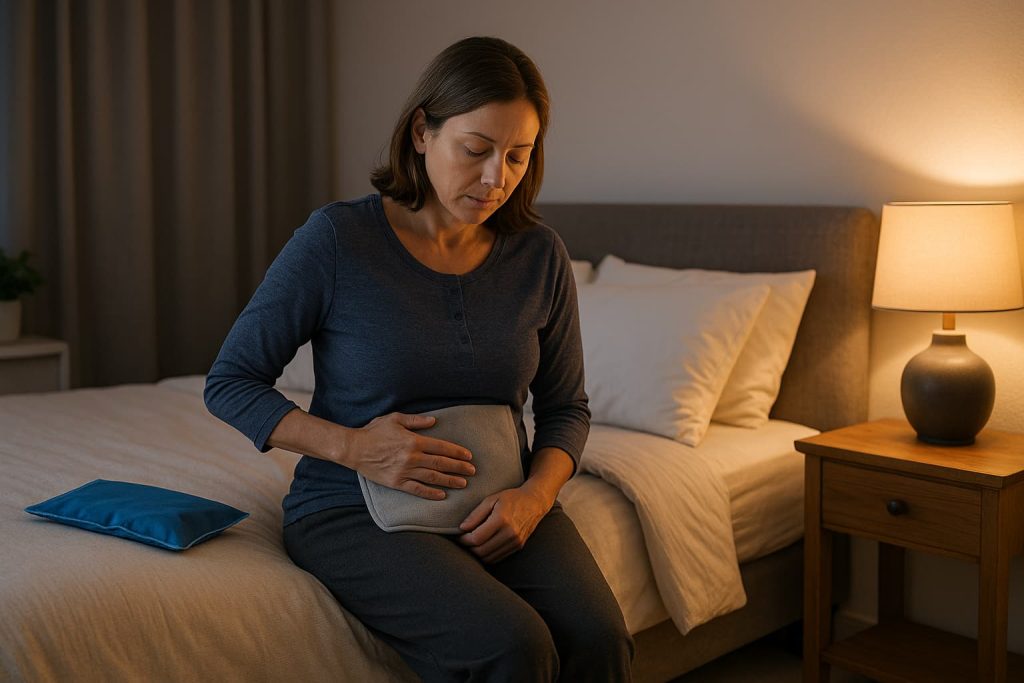
Preparing your body before you lie down can make a significant difference in nighttime comfort. Techniques like heat, cold, and simple relaxation practices help reduce tension, calm irritated nerves, and make it easier for your body to settle into a restful position.
When Heat Can Help
Heat is most effective for easing muscle tightness, stiffness, and chronic tension. Warmth increases blood flow to the area, helping muscles relax and reducing the “guarding” response that often makes pain feel worse at night. This is especially helpful for lower-back discomfort, arthritis stiffness, or tight shoulders.
How to use it:
- Apply warm heat for 10–20 minutes before bed.
- Use a warm compress, warm towel, or gentle heating method.
- Focus on areas that tend to tighten when you lie down.
When Cold Is the Better Choice
Cold therapy is helpful when pain is linked to inflammation, swelling, nerve irritation, or recent flare-ups. Cooling reduces activity in irritated nerves and calms inflammatory responses, making this approach useful for sharp or throbbing pain, inflamed joints, and nerve flare-ups.
How to use it:
- Apply cold for 10–15 minutes before bed.
- Wrap the cold source in a thin cloth to protect your skin.
- Target areas that feel warm, irritated, or intensely sore.
Simple Relaxation Techniques Before Bed
Even a few minutes of relaxation can help calm your nervous system. Options include slow breathing, a warm shower, listening to soothing audio, or resting in a comfortable seated position before bed. These practices help your body shift from tension to rest, making sleep easier to initiate.
Heat, cold, and relaxation techniques work best when used consistently and tailored to how your pain behaves. The goal isn’t to eliminate discomfort completely — it’s to reduce it enough so your body can settle more naturally into sleep.
Gentle Stretching & Mobility to Reduce Tension
Light stretching and simple mobility work before bed can help ease the tightness that builds up throughout the day. Unlike intense stretching or exercise, these movements are slow and controlled, giving your body a chance to soften rather than activate. For many people with chronic pain, this kind of gentle preparation makes it easier to settle into a comfortable sleeping position.
Simple Stretches to Try Before Bed
These stretches are easy to modify and work well with soft surfaces like a bed or mat. Each one prepares your body for rest without adding strain.
Knee-to-Chest Stretch (Lower-Back Release)
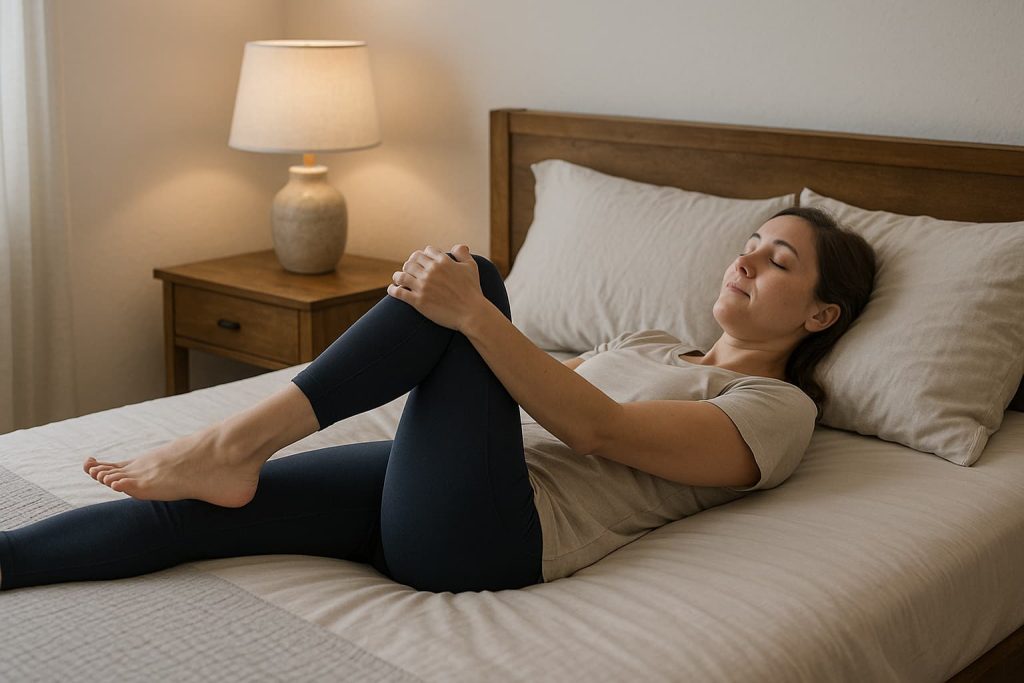
- Lie on your back with your legs extended. Slowly bring one knee toward your chest and hold it with both hands, keeping your shoulders relaxed and your lower back supported.
- What you should feel: a mild stretch in the lower back and hip.
Hold: 20–30 seconds per side.
Seated Hamstring Stretch (Leg & Lower-Back Relief)
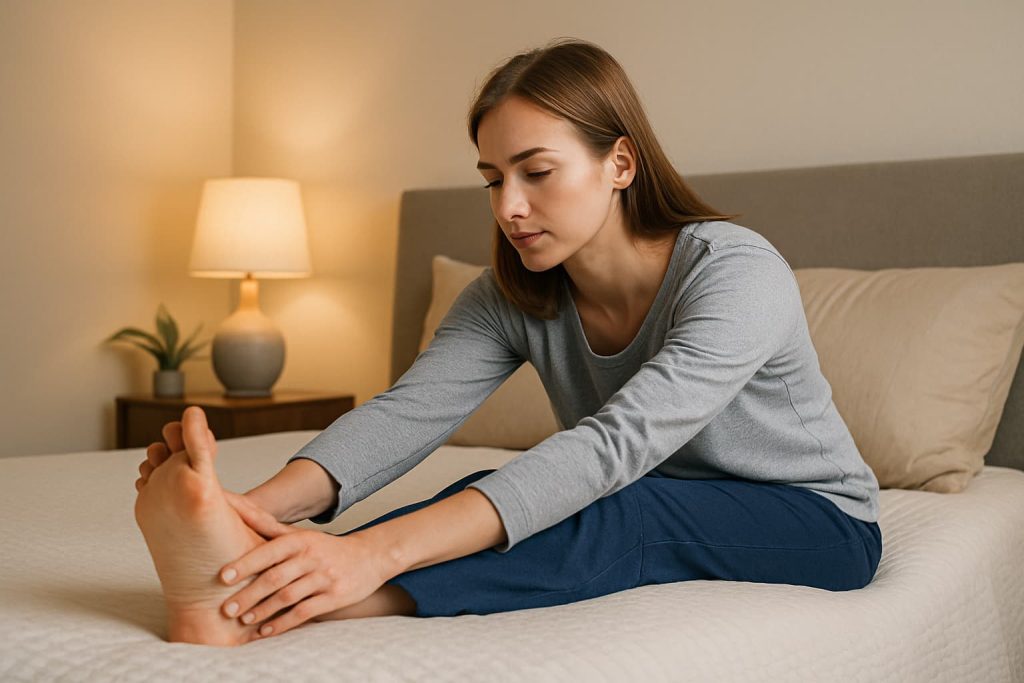
- Sit on the edge of your bed or a mat with one leg extended in front of you. Bend the other leg comfortably and hinge forward from your hips toward your extended foot, keeping your back long and relaxed.
- What you should feel: a light stretch along the back of your thigh and possibly into your lower back.
Hold: 20–30 seconds per side.
Lower-Back Rotations (Spine & Hip Mobility)
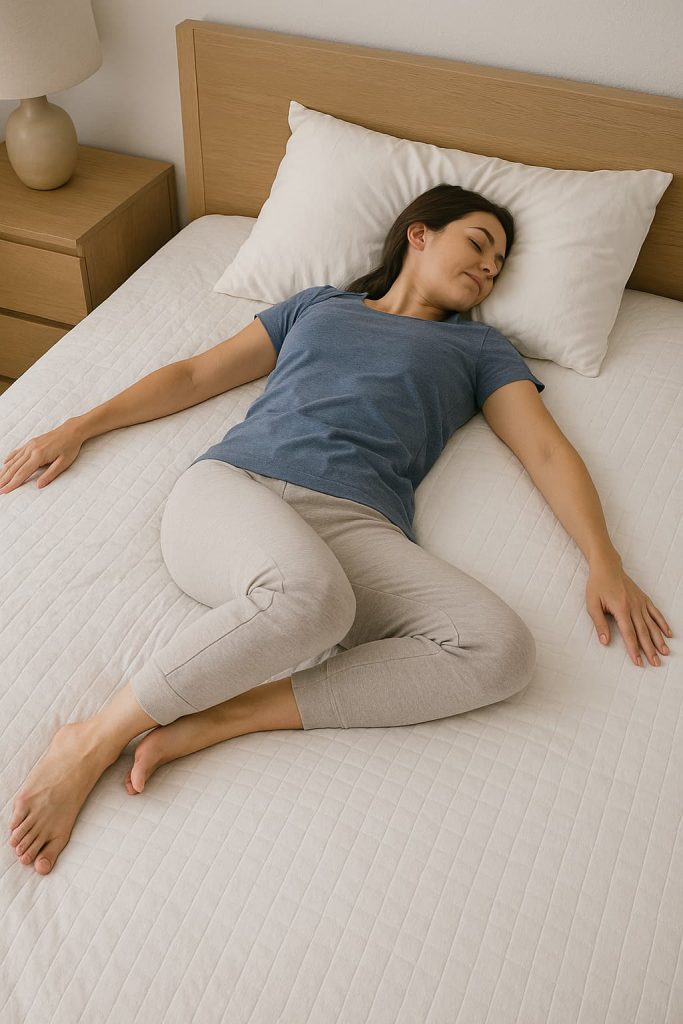
- Lie on your back with your knees bent and feet flat. Gently lower both knees to one side while keeping your shoulders grounded. Pause, return to center, and then lower them to the other side.
- What you should feel: a gentle twisting stretch through the lower back and outer hips.
Repetitions: 5–8 slow rotations per side.
Move With Your Comfort Level in Mind
These stretches should always feel soothing, not sharp or intense. If a position increases discomfort or causes your muscles to tense, ease out right away. Slow, steady breathing can help your body soften into each movement. Consistent, gentle mobility work reduces stiffness, lowers muscle reactivity, and helps your body settle more comfortably at bedtime. Over time, even small stretches can support better sleep and prevent nighttime discomfort from building up.
Calm Your Nervous System at Night

Chronic pain doesn’t just affect your body — it also keeps your nervous system more alert at bedtime. When your system is on high alert, falling asleep becomes harder and nighttime discomfort can feel stronger. Research shows this relationship works both ways: poor sleep increases future pain risk, and existing pain makes sleep more disrupted over time.
(Source: frontiersin.org
Calming your nervous system before bed helps shift your body out of “protective mode” and into a more restful state, making it easier to fall asleep and stay asleep.
Slow, Steady Breathing
Deep, steady breathing helps lower heart rate and reduce muscle tension. One simple method is inhaling for four seconds, exhaling for six, and repeating for one to two minutes. This signals your body that it’s safe to unwind, helping reduce nighttime restlessness.
Body-Scan Relaxation
A body scan involves slowly focusing your attention from head to toe, noticing any areas of tightness and releasing them with each breath. This practice helps reduce muscle guarding and encourages your body to soften before you lie down.
Create a Soothing Evening Atmosphere
Soft lighting, quiet surroundings, and calming activities like reading or listening to calming audio can help deactivate stress responses. Avoiding stimulating content or bright screens in the hour before bed prevents your nervous system from becoming more reactive.
A Warm Bath or Shower
Warmth relaxes tight muscles and supports the body’s natural cooling process as you move into bedtime. The contrast between warm water and cool air afterwards can help your system feel calmer and more ready to rest.
Consistency is key. Calming your nervous system isn’t about one perfect technique—it’s about signaling to your body, night after night, that it’s safe to relax. Over time, these small habits can make sleep feel more attainable, even on nights when pain is more noticeable.
You May Also Like
- 7 Herbal Teas for Better Sleep and STress Relief
- You Want to Sleep Well ? Try One of these Breathing Exerciese Tonight
- Should You Shower Before Bed for Better Sleep?
When to Seek Medical Support
Sometimes sleep struggles related to chronic pain need more than home strategies. A healthcare professional can help identify underlying issues and guide you toward more targeted support.
When Sleep Is Consistently Disrupted by Pain
If pain keeps you awake most nights or wakes you frequently, professional evaluation can help break the cycle. Persistent sleep disruption often means the pain source needs further assessment.
When Symptoms Change or Include Red Flags
Seek medical guidance if your pain suddenly worsens, spreads to new areas, or comes with symptoms like numbness, weakness, swelling, fever, or unusual fatigue. These signs may point to nerve involvement, inflammation, or other conditions that require attention.
A doctor or specialist can pinpoint what’s contributing to your pain, recommend personalized strategies, and coordinate treatments that support both pain relief and better sleep.
Bottom Line:
Sleeping well with chronic pain isn’t about finding one perfect solution — it’s about combining small, supportive changes that help your body relax, ease tension, and settle into rest more comfortably. When you understand what your body needs and make adjustments to your position, environment, and nighttime habits, sleep becomes more attainable, even on challenging nights.
Learning how to sleep well despite chronic pain takes patience, but each simple step you practice builds a foundation for better rest. Experiment with the strategies that feel right for your body, stay consistent with what helps, and give yourself room to adapt on tougher days.
If you’re looking for your next step, explore more sleep guides or continue reading about techniques that support deeper, more restorative rest. Small improvements can add up — and better nights are possible.
FAQs About Sleeping With Chronic Pain
How to sleep with chronic pain?
Sleeping with chronic pain is easier when you focus on reducing pressure, calming your nervous system, and creating a comfortable environment. Gentle stretching, a supportive sleep position, and consistent nighttime habits can all help. These steps form the foundation of how to sleep well despite chronic pain and can make nights more manageable.
Does sleeping help chronic pain?
Yes. Quality sleep allows your body to repair tissues, regulate inflammation, and reset pain-processing pathways in the brain. Even small improvements in sleep can lead to noticeable reductions in pain sensitivity. Consistent rest also helps your muscles relax, which can reduce daytime stiffness and discomfort.
Do people with chronic pain sleep a lot?
People with chronic pain often struggle with disrupted or fragmented sleep rather than oversleeping. Many experience frequent awakenings or difficulty falling asleep, which can lead to daytime fatigue. Some may nap more to make up for poor nighttime sleep, but extended sleep is usually a sign of poor sleep quality, not excess rest.
Can bad sleep cause chronic pain?
Poor sleep can increase inflammation, heighten pain sensitivity, and reduce your body’s ability to recover, making pain feel stronger over time. In some cases, long-term sleep problems can even contribute to developing chronic pain conditions. Improving sleep quality often helps reduce both the intensity and frequency of pain.
Why does chronic pain feel worse at night?
Pain can intensify at night because your body is less distracted, muscle tension builds up throughout the day, and your nervous system becomes more sensitive when you’re tired. Reduced movement and certain sleep positions can also increase pressure on sensitive areas, making discomfort more noticeable.

